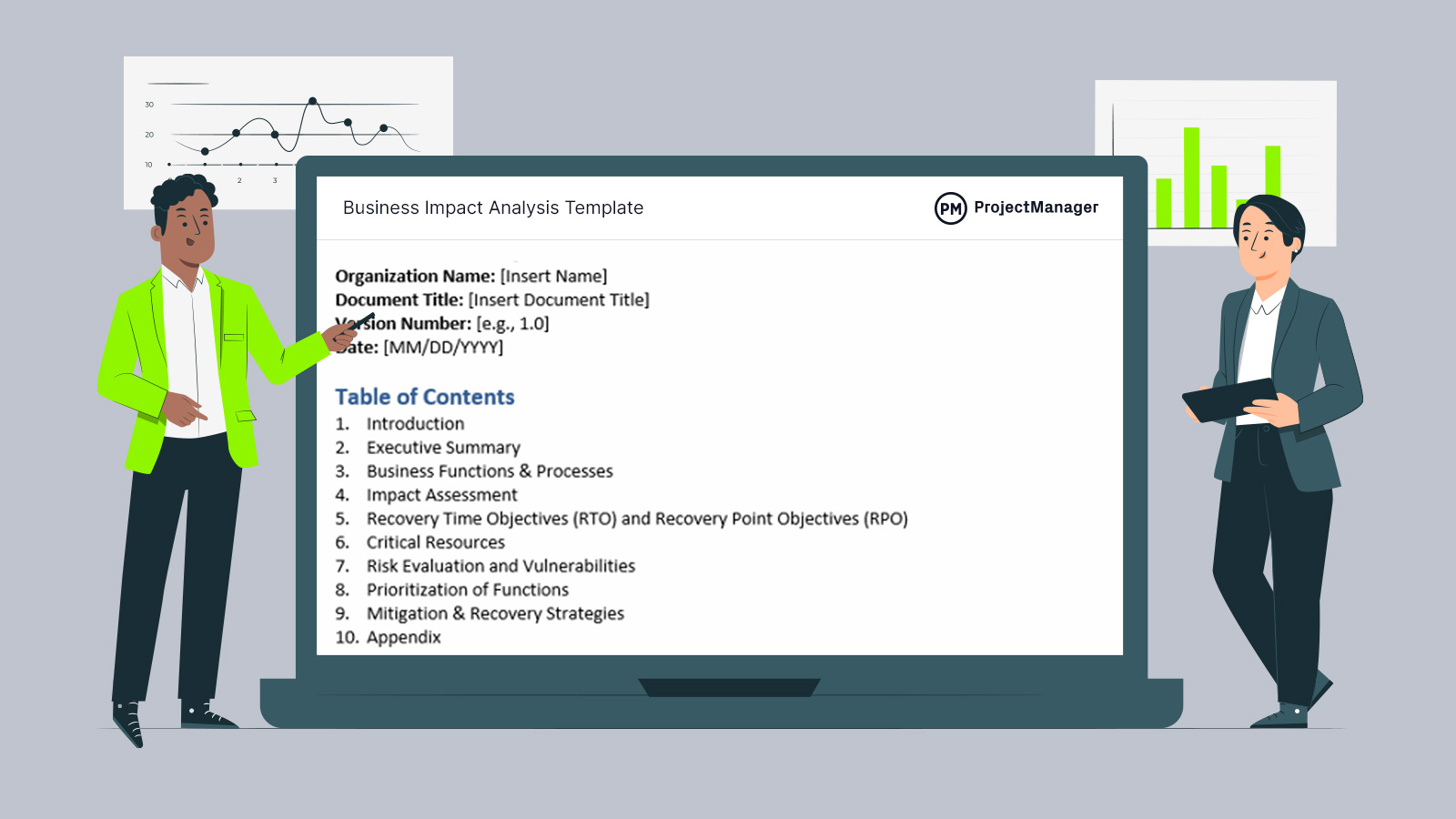A business impact analysis template provides a structured way to assess how disruptions affect critical business functions. It guides teams through identifying essential processes, estimating the potential financial and operational impact of interruptions and prioritizing recovery activities. Using a template ensures consistency across assessments and makes it easier to compare results over time.
This business impact analysis template includes sections for documenting key functions, impact severity, recovery time objectives and required resources. It also provides space to record risks, mitigation plans and action owners so that leaders can turn findings into practical recovery strategies. With a clear template, organizations can quickly produce repeatable, auditable BIA reports that support continuity planning and regulatory requirements.
Project management software accelerates and simplifies the use of a business impact analysis template by centralizing data collection, automating calculations and enabling collaboration. Instead of exchanging spreadsheets or documents, teams can assign tasks, attach evidence and update impact assessments in real time. This reduces errors, speeds up decision-making and ensures that business impact analysis results are integrated with operational plans.
ProjectManager is an ideal choice for running a business impact analysis template because it combines robust planning, tracking and reporting features in one platform. Create tasks for each critical function, set RTOs and RPOs, assign owners and attach supporting documents with robust Gantt charts. Use dashboards to monitor assessment progress and generate professional reports for leadership or auditors. The platform’s collaboration tools keep teams aligned so recovery plans move from assessment to execution faster. Get started with ProjectManager today for free.
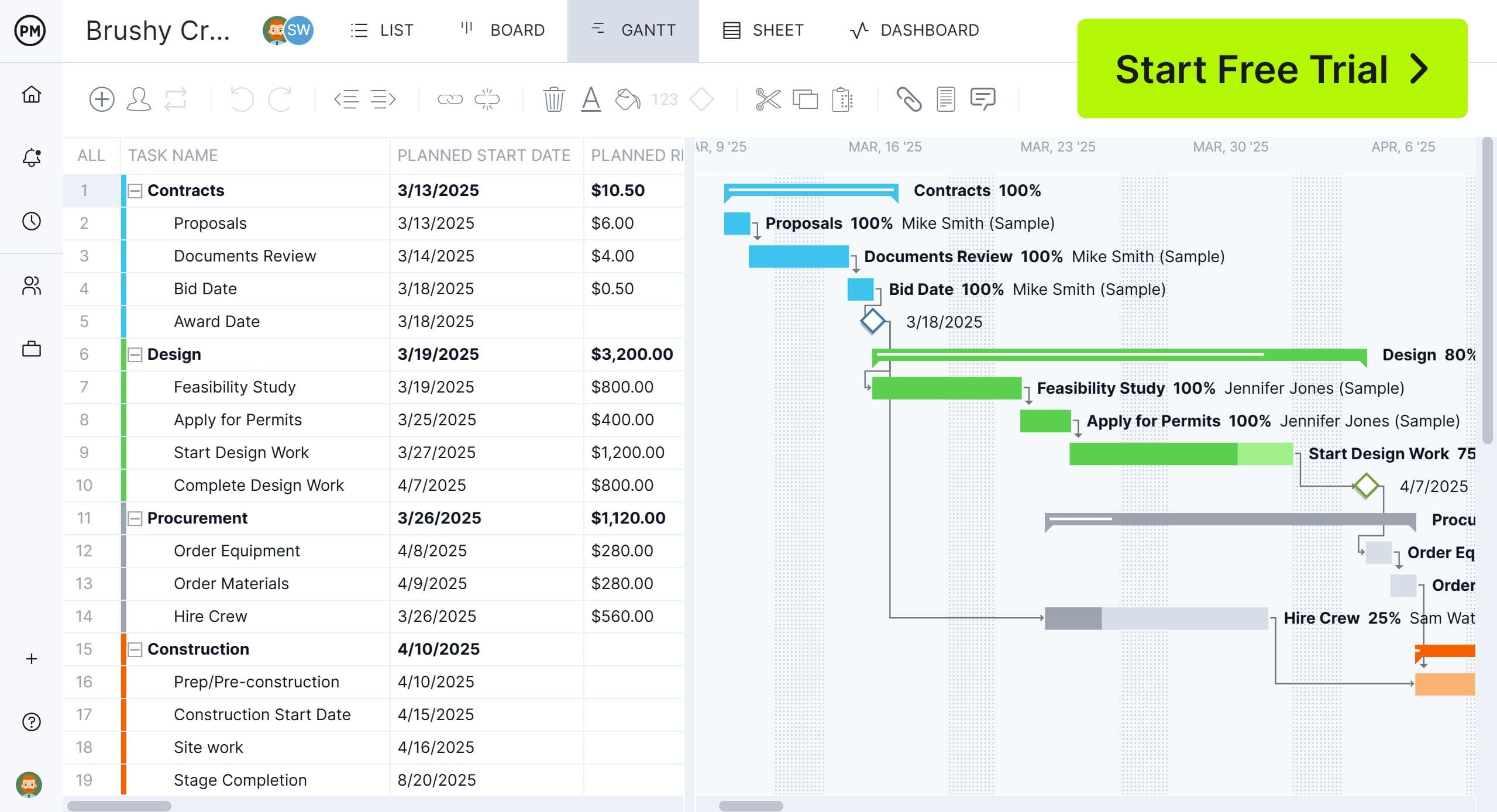
Why You Need a Business Impact Analysis Template
A business impact analysis template helps organizations identify which functions are most critical and estimate the consequences of downtime. It provides a repeatable framework for assessing operational, financial and reputational impacts so leaders can prioritize recovery efforts. By standardizing the assessment process, the template ensures that nothing important is missed and that decisions are based on consistent data.

When to Use a Business Impact Analysis Template
Use a business impact analysis template during business continuity planning, before major organizational changes, after risk assessments or periodically as part of compliance requirements. It’s useful when preparing for known risks like system migrations, supplier changes or severe weather seasons. Regular use of the template keeps recovery plans current and aligned with evolving business priorities.
Who Should Use this Free Business Impact Analysis Template?
This business impact analysis template is valuable for risk managers, continuity planners, IT leaders, operations managers and executives who need to understand business-critical processes. It’s also useful for internal audit teams and consultants conducting continuity reviews or compliance assessments. The template provides a common language for cross-functional teams to evaluate impacts and plan recovery actions.
How to Use This Business Impact Analysis Template for Word
This section walks you through applying the business impact analysis template so you can produce consistent, actionable results. Each step maps to a sheet or section in the template that captures the necessary data for meaningful continuity planning.
1. Identify Key Business Functions and Processes
List the core functions your organization depends on, such as order processing, payroll, manufacturing or customer support. For each function, document the sub-processes that enable it to run. This creates the foundation of your business impact analysis template and ensures every critical activity is covered.
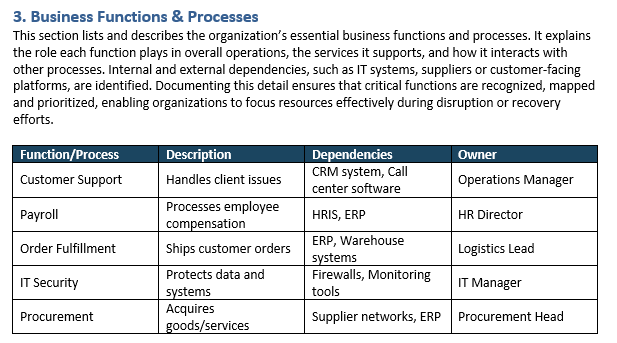
2. Assess the Impact of Disruptions in Key Business Functions and Processes
For each function, estimate the operational, financial and reputational consequences of downtime at different intervals, such as 24 hours, 72 hours and one week. Use the business impact analysis template to capture qualitative and quantitative impacts so you can prioritize recovery actions by severity.
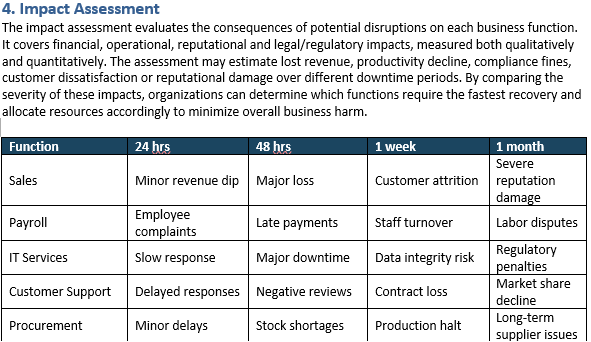
3. Define Recovery Time Objectives (RTO) & Recovery Point Objectives (RPO)
Set the maximum acceptable downtime for each function (RTO) and the acceptable data loss window (RPO). Record these values in the template so recovery priorities are clear. RTOs and RPOs help determine the resources and strategies needed to restore services within acceptable limits.
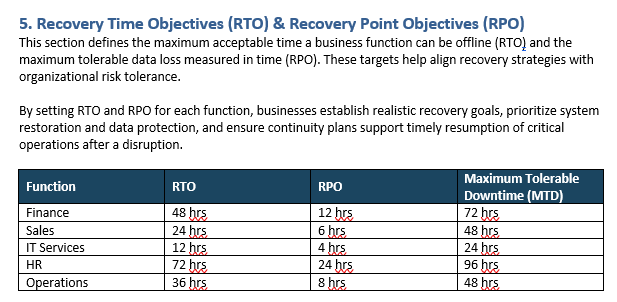
4. Identify Critical Resources for Key Business Functions and Processes
List the people, systems, locations and third-party suppliers required to run each function. Capture dependencies such as network access, specialist staff or raw materials in the business impact analysis template so recovery plans can account for every resource needed to resume operations.
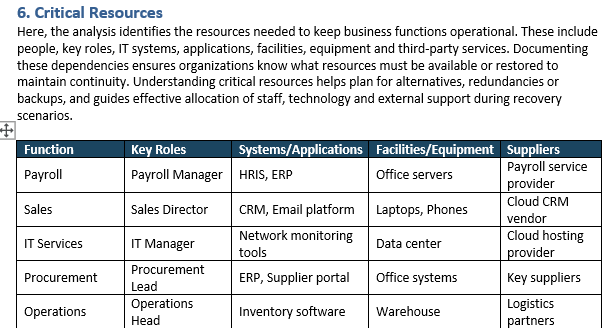
5. Analyze Potential Risks
Use the template to document the risks that could cause disruptions, such as cyberattacks, equipment failure, supplier outages or natural disasters. Assess the likelihood and potential impact of each risk so you can focus mitigation efforts where they will reduce the most exposure.
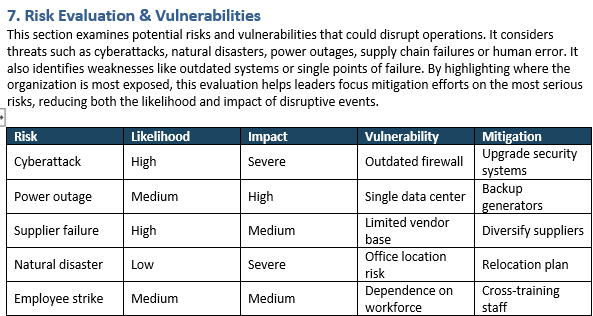
6. Plan Mitigation & Recovery Strategies
For the highest priority impacts, define practical mitigation and recovery actions in the template. Assign owners, set deadlines and list required resources. Include steps for short-term containment and longer-term recovery so the organization can act quickly and measure progress against the plan.

What Other Templates Can Help With Business Management?
Complement your business impact analysis template with financial and planning templates that provide the inputs and context needed for sound recovery planning.
Balance Sheet Template
Download this free balance sheet template to capture an organization’s assets and liabilities, giving a snapshot of financial health that informs impact assessments and resource availability.
Profit and Loss Statement Template
Use this free profit and loss statement template to quantify revenue impacts and cost exposures from business interruptions so you can calculate financial impact more accurately within your BIA.
Operating Budget Template
An operating budget template lays out recurring costs and planned expenditures, which is useful when estimating the financial resources required for recovery and sustained operations after a disruption.
How ProjectManager Helps Businesses Across Industries
ProjectManager supports business impact analysis and continuity planning by centralizing assessment data, automating tracking and enabling collaboration across departments. Its integrated tools make it easier to turn a business impact analysis template into executable recovery plans, monitor progress and report status to stakeholders in real time.
Assign and Monitor Recovery Work
Use task lists, kanban boards and Gantt charts to assign recovery actions, sequence work and visualize dependencies. Workload views show who is available so you can avoid overallocating staff during recovery. Built-in timesheets and cost tracking keep recovery budgets visible so you can manage spending while restoring operations.
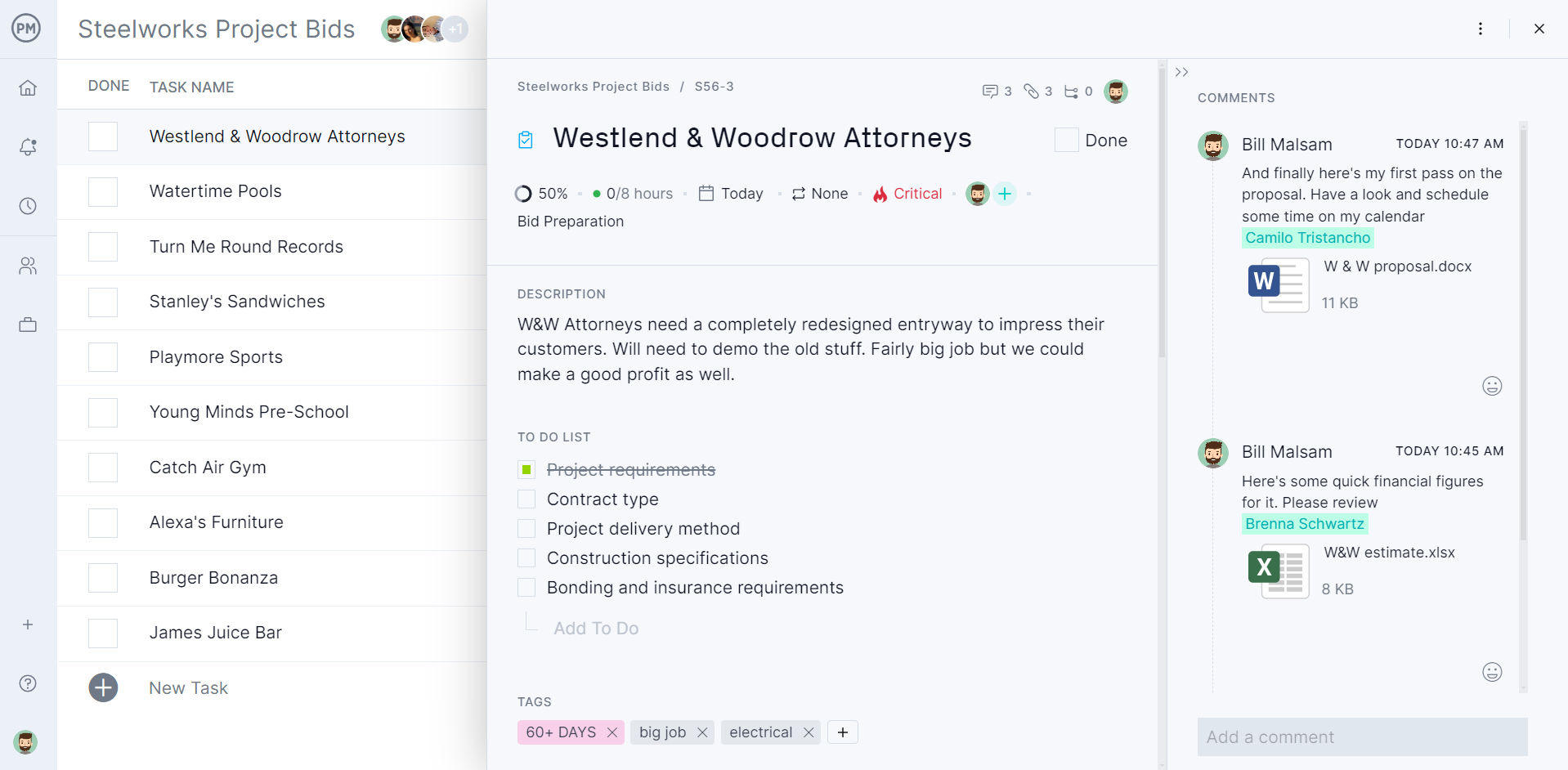
Report and Communicate With Confidence
ProjectManager’s dashboards and customizable reports let you generate BIA summaries for executives or auditors instantly. Attach evidence, link tasks to supporting documentation and share live views with stakeholders so decisions are based on current data. This reduces reporting delays and strengthens governance during critical incidents.

Related Content
- How to Write a Business Plan
- Aligning Your Project to Business Strategy
- What Is Organizational Strategy in Business?
- Strategic Planning in Business
- Importance of Scenario Planning and Analysis in Business
- What Is a Business Budget? Business Budgeting Basics
- 32 Free Excel Templates for Business
- Business Forecasting: Why You Need It & How to Do It
ProjectManager is online project and portfolio management software that connects teams, whether they’re in the office or out in the field. They can share files, comment at the task level and stay up to date with email and in-app notifications. Get started with ProjectManager today for free.
